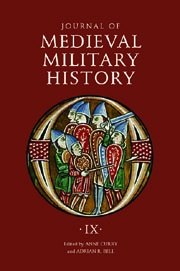Book contents
- Frontmatter
- Contents
- List of Illustrations
- Preface
- The French Offensives of 1404–1407 against Anglo-Gascon Aquitaine
- The King's Welshmen: Welsh Involvement in the Expeditionary Army of 1415
- Gunners, Aides and Archers: The Personnel of the English Ordnance Companies in Normandy in the Fifteenth Century
- Defense, Honor and Community: The Military and Social Bonds of the Dukes of Burgundy and the Flemish Shooting Guilds
- The Battle of Edgecote or Banbury (1469) Through the Eyes of Contemporary Welsh Poets
- Descriptions of Battles in Fifteenth-Century Urban Chronicles: A Comparison of the Siege of London in May 1471 and the Battle of Grandson, 2 March 1476
- Urban Espionage and Counterespionage during the Burgundian Wars (1468–1477)
- Urban Militias, Nobles and Mercenaries: The Organization of the Antwerp Army in the Flemish–Brabantine Revolt of the 1480s
- Military Equipment in the Town of Southampton During the Fourteenth and Fifteenth Centuries
- Journal of Medieval Military History 1477 545X
The French Offensives of 1404–1407 against Anglo-Gascon Aquitaine
Published online by Cambridge University Press: 05 February 2013
- Frontmatter
- Contents
- List of Illustrations
- Preface
- The French Offensives of 1404–1407 against Anglo-Gascon Aquitaine
- The King's Welshmen: Welsh Involvement in the Expeditionary Army of 1415
- Gunners, Aides and Archers: The Personnel of the English Ordnance Companies in Normandy in the Fifteenth Century
- Defense, Honor and Community: The Military and Social Bonds of the Dukes of Burgundy and the Flemish Shooting Guilds
- The Battle of Edgecote or Banbury (1469) Through the Eyes of Contemporary Welsh Poets
- Descriptions of Battles in Fifteenth-Century Urban Chronicles: A Comparison of the Siege of London in May 1471 and the Battle of Grandson, 2 March 1476
- Urban Espionage and Counterespionage during the Burgundian Wars (1468–1477)
- Urban Militias, Nobles and Mercenaries: The Organization of the Antwerp Army in the Flemish–Brabantine Revolt of the 1480s
- Military Equipment in the Town of Southampton During the Fourteenth and Fifteenth Centuries
- Journal of Medieval Military History 1477 545X
Summary
From 1396 the realm of England was at peace with the kingdom of France, thanks to the long truce signed by Richard II and Charles VI and the marriage of the former with Isabella, daughter of the latter. However, the deposition of Richard by Henry of Lancaster in 1399 changed the situation. Charles's brother, Louis, duke of Orléans, had considerable influence over the sick king, and became the staunchest supporter of a new war against England. Although Orléans had entered into an alliance with the duke of Lancaster in 1399 in order to gain support against John the Fearless, duke of Burgundy, after Henry's accession he became the English king's most determined opponent at the French court. The exact reasons for his hostility towards Henry are difficult to establish. Perhaps the deposition of Richard II, who was son-in-law of Charles VI, was sufficient in itself, but we may also suspect that Orléans exploited an anti-English line to reinforce his own hold on the French royal government against the Burgundians.
The attention of Louis of Orléans was logically focused on the duchy of Aquitaine (known in French as Guyenne). At this point Gascony, the western part of the duchy, was the only possession of the king of England on the mainland of France save for Calais. But Orléans' interest was also personal. As count of Angoulême he was one of the most important lords of the duchy.
- Type
- Chapter
- Information
- Journal of Medieval Military History , pp. 1 - 40Publisher: Boydell & BrewerPrint publication year: 2011

